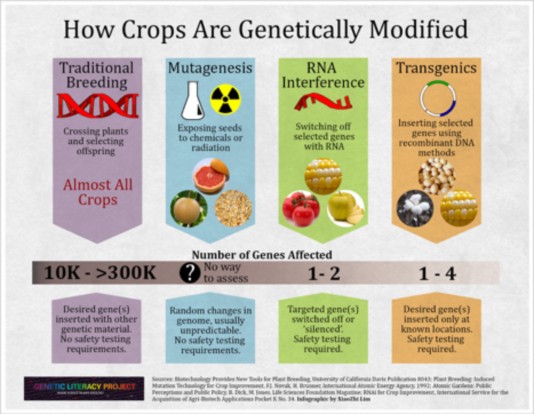ARTICLE: Perplexing Case of Consumer Confusion About GE Foods
The following is an excerpt of a report by Brandon McFadden, Assistant Professor in the Food and Resource Economics Department, University of Florida, for the Genetic Literacy Project.
Despite a lack of basic knowledge about agricultural production, consumers are taking a more assertive role in the food value chain. There is much to applaud about the vibrancy of a market that offers consumers what they want. But, as research in behavioral economics has shown, they may not always know what they want or logically evaluate the alternatives, particularly when it comes to public policy in which the consequences and costs are often far from obvious. Research has shown that people are poorly educated about basic science and genetics, which is one of the key reasons why there is so much conflicting results stemming from consumer polls regarding food.
A majority of consumers mistakenly but consistently believe that all unprocessed food is “as nature made it.” This is simply not true. Consider ancient maize, for example. It’s believed that corn was first developed about 7,000 years ago when early agriculturalists began modifying a wild, inedible grass called teosinte. Many people do not realize that it took thousands of years of modifications to create modern corn (sweet corn is only a few hundred years old). When Oklahoma State agricultural economist Jayson Lusk and I conducted a survey on attitudes about what we eat, we found that approximately 49 percent of respondents thought the genetic structure of corn had never varied prior to genetically engineered (GE) corn, which was first grown in 1996.
Our survey also showed that 34 percent of respondents thought genetically engineered (GE) tomatoes contained altered genes but non-GE tomatoes did not, and 32 percent thought fresh vegetables did not contain DNA. In addition, respondents thought that more than 50 percent of corn and wheat acreage was GE. The actual acreage of GE corn is 92 percent, but there is no commercially approved GE wheat. These findings underscore how challenging it is to understand consumer skepticism about GE food. Even in countries such as the United States, consumers have little knowledge and many misconceptions about genetics and agriculture production in general.
Natural Conundrum
A lack of knowledge about genetics does not preclude a majority of consumers from believing that the GE breeding technique is “playing with nature.” Nearly half of consumers are unaware that other breeding techniques, such as mutagenesis and wide crossing, also alter genes. How various breeding techniques alter genes is shown in the infographic below.
Note that the two conventional breeding techniques, crossing plants and mutagenesis, result in the most number of affected genes. The perception that the GE breeding technique is distinctly unnatural may be exacerbated by associations with terms such as genetic engineering, genetic modification (GM) and genetically modified organisms (GMOs).
When Professor Lusk and I asked questions about how many genes are altered by various breeding techniques, a significant proportion of respondents thought GE altered more genes than most other breeding techniques, with the exception of hybridization which is a conventional breeding technique that has been used since the 1920s involving the crossing of two genetically different plants. Many thought traditional selective breeding, which affects tens or hundreds of thousands of genes randomly, did not alter any genes. Respondents viewed it as the most “natural” breeding technique.
A joint 2016 study by psychologists at the Universities of Pennsylvania and Toronto found a near majority (45%) perceived GE food as “unnatural” and intrinsically disgusting, and thought “GE food should be prohibited no matter the risks and benefits.” Our research has shown that GE animal products are viewed as more offensive than GE vegetables or fruits, and fresh GE foods are viewed as more offensive than processed GE foods. On average, respondents ranked beef as more desirable than corn or apples when all were non-GE. However, if all were GE, then respondents ranked corn or apples as more desirable than beef. These findings indicate that consumer aversion to GE foods is not uniform across all food products.
To read the entire report, please click here.




